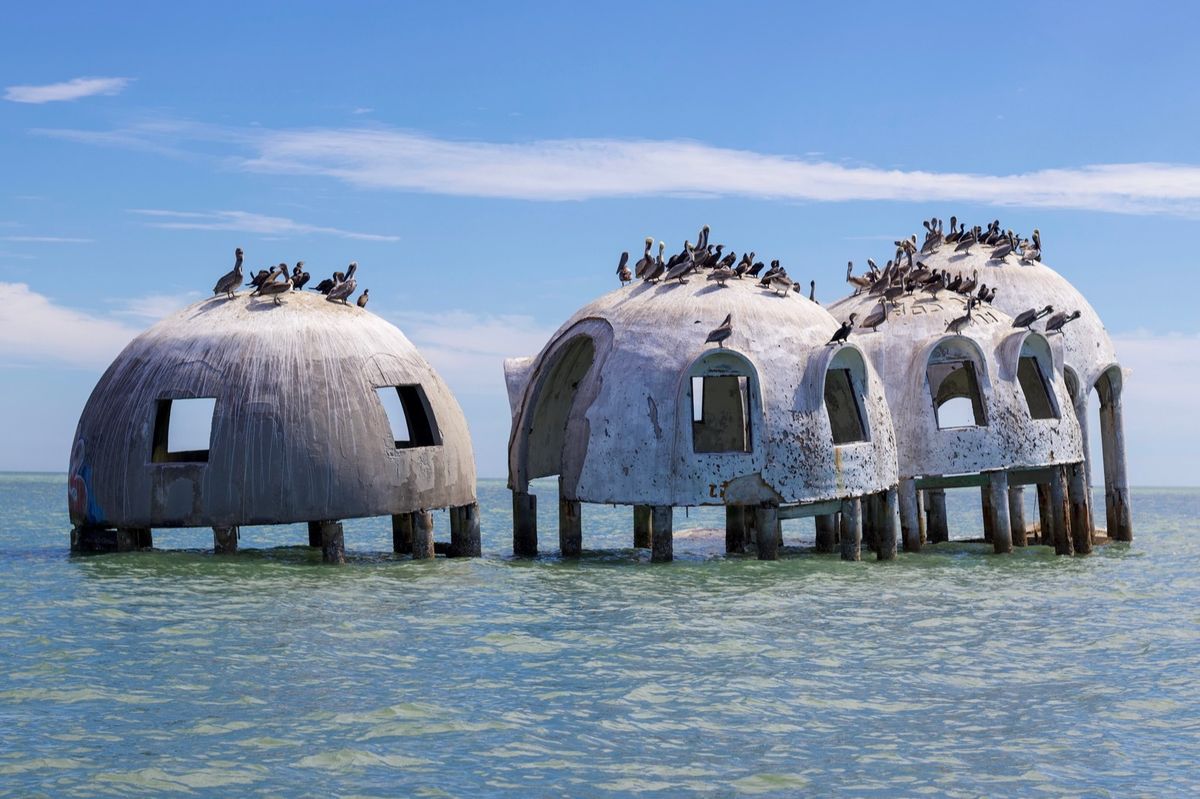
What happened to the Cape Romano Dome House? This question has puzzled many who have seen pictures of the strange, futuristic structures off the coast of Florida. Built in 1981 by retired oil producer Bob Lee, the Cape Romano Dome House was once a luxurious vacation home. Over the years, it faced numerous challenges from nature, including hurricanes and rising sea levels. These forces gradually eroded the land beneath the domes, causing them to sink into the ocean. Today, the domes stand as eerie, partially submerged relics, attracting curious visitors and marine life alike. Their story is a fascinating blend of human ambition and nature's relentless power.
Key Takeaways:
- The Cape Romano Dome House, built in the 1980s, is a unique and resilient structure off the coast of Florida, facing environmental challenges but inspiring hope and creativity.
- This iconic house, with its futuristic design and environmental significance, has become a symbol of human ingenuity and the need for sustainable adaptation to changing conditions.
The Origins of Cape Romano Dome House
The Cape Romano Dome House is an architectural marvel located off the coast of Florida. Built in the 1980s, this unique structure has captured the imagination of many. Here are some fascinating facts about this iconic house.
-
The Cape Romano Dome House was constructed in 1982 by retired oil producer Bob Lee.
-
It was originally built on a ten-acre plot of land on Cape Romano, a barrier island south of Marco Island, Florida.
-
The house consists of six interconnected dome structures, each serving a different purpose such as living quarters, kitchen, and bedrooms.
-
Bob Lee designed the house to be self-sustaining, incorporating solar panels and a rainwater collection system.
-
The domes were constructed using a mixture of concrete and sand, making them highly durable and resistant to hurricanes.
The Unique Design and Construction
The design of the Cape Romano Dome House is not only visually striking but also highly functional. Its construction methods and materials were chosen to withstand the harsh coastal environment.
-
The dome shape was chosen for its aerodynamic properties, allowing wind to flow over and around the structure, reducing the risk of damage during storms.
-
Each dome was built on stilts to elevate the house above the ground, protecting it from flooding and storm surges.
-
The house was painted white to reflect sunlight and keep the interior cool in the hot Florida climate.
-
The interior of the domes featured open floor plans, maximizing the use of space and natural light.
-
Large windows were installed to provide panoramic views of the surrounding landscape and ocean.
Environmental Challenges and Changes
Over the years, the Cape Romano Dome House has faced numerous environmental challenges. Rising sea levels and coastal erosion have significantly impacted the structure.
-
In the early 2000s, the house was abandoned due to increasing maintenance costs and the encroaching sea.
-
By 2005, the house was completely surrounded by water, making it accessible only by boat.
-
Coastal erosion has caused the land around the house to disappear, leaving the domes standing on their stilts in the ocean.
-
Despite being abandoned, the structure has remained largely intact, a testament to its robust construction.
-
The house has become a popular spot for boaters and tourists, who are drawn to its unique appearance and history.
The House's Role in Popular Culture
The Cape Romano Dome House has not only been a subject of architectural interest but has also made its mark in popular culture.
-
The house has been featured in numerous articles, documentaries, and television shows, highlighting its unique design and history.
-
It has become a popular subject for photographers and artists, who are captivated by its otherworldly appearance.
-
The house has inspired various architectural projects and designs, showcasing the potential of dome structures.
-
It has also been a topic of discussion in environmental circles, serving as a case study for the impacts of climate change and coastal erosion.
-
The house's story has been shared widely on social media, attracting a global audience interested in its fate.
Preservation Efforts and Future Prospects
Efforts have been made to preserve the Cape Romano Dome House and protect it from further damage. Various proposals have been put forward to save this iconic structure.
-
In 2017, a group of local residents and environmentalists launched a campaign to save the house from collapsing into the sea.
-
Proposals have included building a seawall around the house to protect it from further erosion and rising sea levels.
-
Another idea is to relocate the domes to a more stable location, preserving them for future generations.
-
Despite these efforts, the future of the Cape Romano Dome House remains uncertain, as the cost and feasibility of such projects are still being evaluated.
-
The house continues to be a symbol of resilience and ingenuity, inspiring those who visit it.
Interesting Tidbits and Lesser-Known Facts
Beyond its architectural and environmental significance, the Cape Romano Dome House has a number of lesser-known facts that add to its intrigue.
-
The house was originally intended to be a vacation home for Bob Lee and his family.
-
It was designed to be energy-efficient, with features such as natural ventilation and passive solar heating.
-
The domes were constructed using a unique method called "airform," where a balloon-like structure was inflated and then covered with concrete.
-
The house was equipped with a state-of-the-art septic system, allowing it to function independently of municipal services.
-
Over the years, the house has become a habitat for various marine life, including fish, birds, and even sea turtles.
The House as a Symbol
The Cape Romano Dome House stands as a symbol of human ingenuity and the challenges posed by nature. Its story continues to captivate and inspire.
-
The house has been compared to a futuristic spaceship or a set from a science fiction movie.
-
It has been used as a backdrop for various photo shoots and film projects, adding to its mystique.
-
The house's unique design has sparked interest in dome architecture and its potential applications in other areas.
-
It serves as a reminder of the importance of sustainable design and the need to adapt to changing environmental conditions.
-
The house's resilience in the face of adversity has made it a symbol of hope and perseverance.
The House's Impact on the Community
The Cape Romano Dome House has had a significant impact on the local community, drawing attention to the issues of coastal erosion and climate change.
-
The house has become a landmark in the area, attracting visitors and boosting local tourism.
-
It has sparked discussions about the need for better coastal management and the importance of protecting vulnerable areas.
-
The house has inspired local artists and photographers, who have created works based on its unique design and history.
-
It has also served as an educational tool, teaching people about the impacts of climate change and the importance of sustainable design.
The Final Word on Cape Romano Dome House
Cape Romano Dome House stands as a testament to human ingenuity and nature's power. Built in 1980 by Bob Lee, this unique structure has faced hurricanes, erosion, and rising sea levels. Despite these challenges, it remains a fascinating sight off the coast of Florida. The domes, once a luxurious retreat, now serve as a haunting reminder of nature's unpredictability. They attract tourists, photographers, and marine life alike. While the future of the Dome House is uncertain, its story continues to captivate those who learn about it. Whether you're a history buff, architecture enthusiast, or just curious, the Cape Romano Dome House offers a glimpse into a world where human ambition meets natural forces. So next time you're in Florida, consider a trip to see this remarkable piece of history before it disappears beneath the waves.
Frequently Asked Questions
Was this page helpful?
Our commitment to delivering trustworthy and engaging content is at the heart of what we do. Each fact on our site is contributed by real users like you, bringing a wealth of diverse insights and information. To ensure the highest standards of accuracy and reliability, our dedicated editors meticulously review each submission. This process guarantees that the facts we share are not only fascinating but also credible. Trust in our commitment to quality and authenticity as you explore and learn with us.


